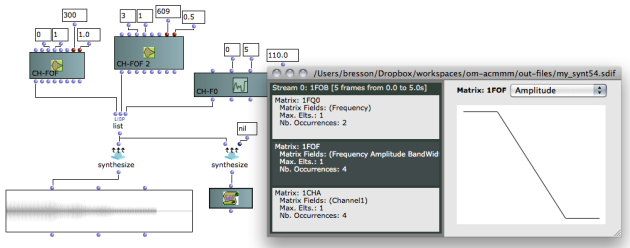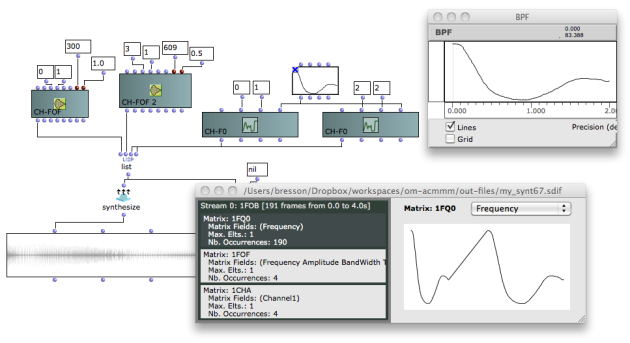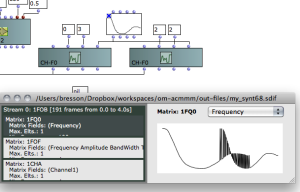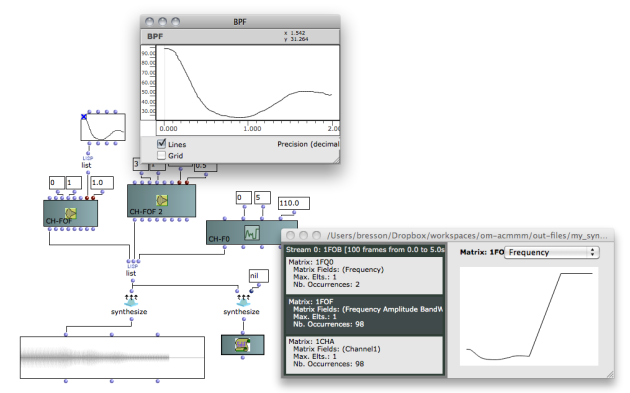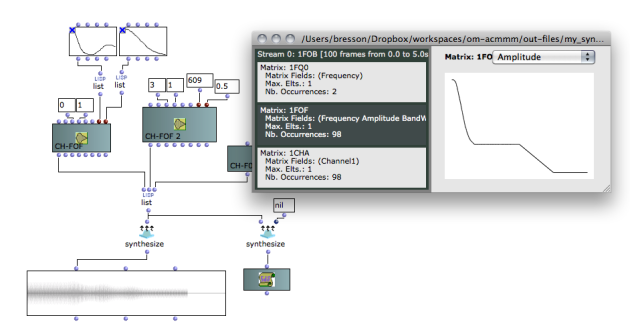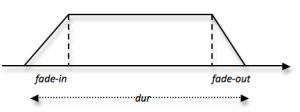Events Duration and "Continuous" Control
Event duration (basics)
The control framework proposed by the Chant classes simulates the notion of event in the actual sequence of control frames sent to the synthesizer.
The procedures explained below are most often transparent to the user; however, they may help understanding the principles and better leverage the possibilities offered by the system.
In the simple case of constant values (i.e. when numbers – and not BPFs – are provided as values for the matrix components), the event is simulated by duplicating the control values twice in the final SDIF frame stream: one time at tb, the event's action-time, and one second time at te = action-time + dur. This way, the parameter values remains stable during the whole duration of the event, and do not interpolate to the values of the next one until the end of this event.

The activation time of the synthesis module, as well as the total duration of the synthesis if not provided as an argument to SYNTHESIZE, is determined automatically by taking into account the greater end time (action-time + dur) among all Chant events.
On the following example we can observe the curve generated by the 4 points delimitating 2 CH-FOF events. Not that after the second event ends, the FOF module shuts down and the rest of the sound is null, although the F0 is still running 1s more. The resulting sound has therefore 1s of silence at the end.
When parameters are specified using BPFs, the duration of the event is subject to different possible interpretations.
In the case of simple events (CH-F0, CH-NOISE) the BPF is scaled to the specified duration. In the following example, we see two CH-F0 objects with the same F0 curve of appx. 2s. One scaled to a duration of 1s (in the first event), and the other one remains of 2s duration. The resulting F0 control sequence is visible in the SDIFFile editor.
The case of matrix events (CH-FOF, CH-FLT) is detailed in the next section.
Like in the case of constant event values, the overlapping of continuous controls, if not handled explicitly, can lead to important artefacts in the control sequence. |
Handling of continuous controls with matrix events (CH-FOF, CH-FLT)
Matrix events (CH-FOF, CH-FLT) can have one or several parameters, and for one or several of their inner components, specified as “continuous controls” in the form of BPFs. In this case, and because of possible conflicts between the several parameters, the dur parameter is ignored and the duration of the BPF determines the real duration of the event.
In the following example the duration of the first CH-FOF event is 2s (as described in the BPF) and the 1s duration specified for dur is ignored.
In order to set a continuous evolution for CH-FOF or CH-FLT events, the function LIST must be used, event if there is only one BPF. Using a BPF alone (without LIST) provokes the sampling on the BPF over the different components of the matrix, as described in Section "Chant events" / "Setting the chant event attributes".
When several components of an event, or several parameters for a given component, are specified with continuous controls (BPFs), the longest one is determines the duration of the event. The other one (as well as the constant parameters) keep their last value until the end of the event's duration. In the example below, the amplitude BPF is shorter than the frequency BPF, and therefore keeps is last value until the end of the first event.
Since all parameters of a given Chant module (say, a FOF generator) have to be specified synchronously in common SDIF frames, they must all be interpolated at the update rate of the continuous controls. The case where several parameters/components are controlled with BPFs can therefore lead to high computational costs. In order to reduce this computational cost, a global control rate can be specified with the <kt> attribute of the event.
Fade In, Fade Out
It is convenient to consider CHANT event as separate entities in a phrase, and therefore to be able to control transitions between such events (see Section "Transitions") or to separate these events (as in a “staccato” sequence). OM-Chant classes allow to isolate events with a fade-in/fade-out parameter, supplied in addition to the event duration in the dur slot of the events.
In order to set a fade in/out duration, just connect a list (duration in out) instead of the single duration value. The fade in/out applies to:
- amplitudes with CH-FOF, CH-FLT and CH-NOISE objects ;
- f0 with the CH-F0 objects.
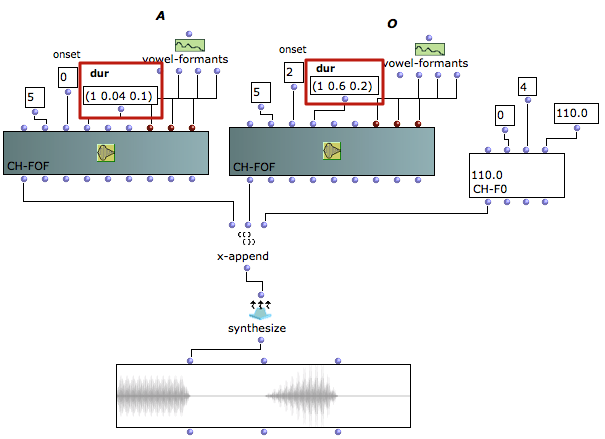
Applying the fade-in / fade out on a CH-F0 object will not modify the amplitude but the frequency of the synthesis (F0 events have no amplitude). When f0 = 0, the FOF is also silent. This can produce interesting effects of pitch evolutions in a phrase.
